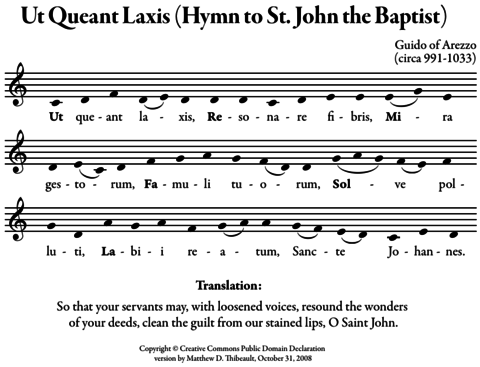Ut queant laxis
Ut queant laxis or Hymnus in Ioannem are verses in honour of John the Baptist written in Horatian Sapphics by Paulus Diaconus, the eighth century Lombard historian. The first syllable of each hemistich (half line of verse) has given its name to a successive note. The use of Ut queant laxis to name the tones is usually attributed to Guido of Arezzo in the eleventh century, who proposed a name for the first six tones. Later, the "si" was added in the 18th century.
The musical origins of the hymn are less clear, but the melody shares a common ancestor with the eleventh-century arrangement of Horace's Ode to Phyllis (4.11) recorded in the Montpellier manuscript H425. In this melody, each of the first six musical phrases of each stanza of the hymn begins on a successively higher note of the hexachord, corresponding to the tone proposed by Guido of Arezzo, except the last line, Sancte Iohannes, which is an adonius after the three Sapphic hendecasyllables, breaking the ascending pattern. It is possible that the music was created by Guido of Arezzo himself or is just a re-use of a former melody[1].

In the Roman rite, the hymn is sung in the Divine Office on June 24, the Feast of the Nativity of John the Baptist. The full hymn is divided into three parts, with Ut queant laxis sung at Vespers, Antra deserti sung at Matins, O nimis felix sung at Lauds, and doxologies added after the first two parts.
The first stanza is:
- Ut queant laxis
- resonare fibris,
- Mira gestorum
- famuli tuorum,
- Solve polluti
- labii reatum,
- Sancte Iohannes.
It may be translated: So that your servants may, with loosened voices, resound the wonders of your deeds, clean the guilt from our stained lips, O Saint John.
Ut is now mostly replaced by Do in solfège due to the latter's open sound, in deference to Italian theorist Giovanni Battista Doni.[2]. The word "Ut" is still in use to name the C-clé. The seventh note was not part of the medieval hexachord and does not occur in this melody, and it was originally called "si" from "Sancte Ioannes". In the nineteenth century, Sarah Glover, an English music teacher, renamed "si" to "ti" so that every syllable might begin with a different letter. But this proposition had had no impact on the usage of "si" in the countries where "si" was already in use (in Romance languages, there is no confusion between the sound "si" and the sound "sol").
Melody:
See also
- Diatonic and chromatic
- Gamut
- Guidonian hand
- Solmization
- Solfège
- Stuart Lyons, "Music in the Odes of Horace" (2010), Oxford, Aris & Phillips, ISBN 978-0-85668-844-7.
References
- ^ Template:FrUt queant laxis in Encyclopédie Larousse
- ^ McNaught, W. G. (1893). "The History and Uses of the Sol-fa Syllables". Proceedings of the Musical Association. 19. London: Novello, Ewer and Co.: 43. ISSN 0958-8442. Retrieved 2010-12-12.

